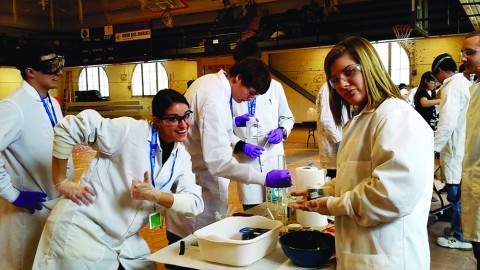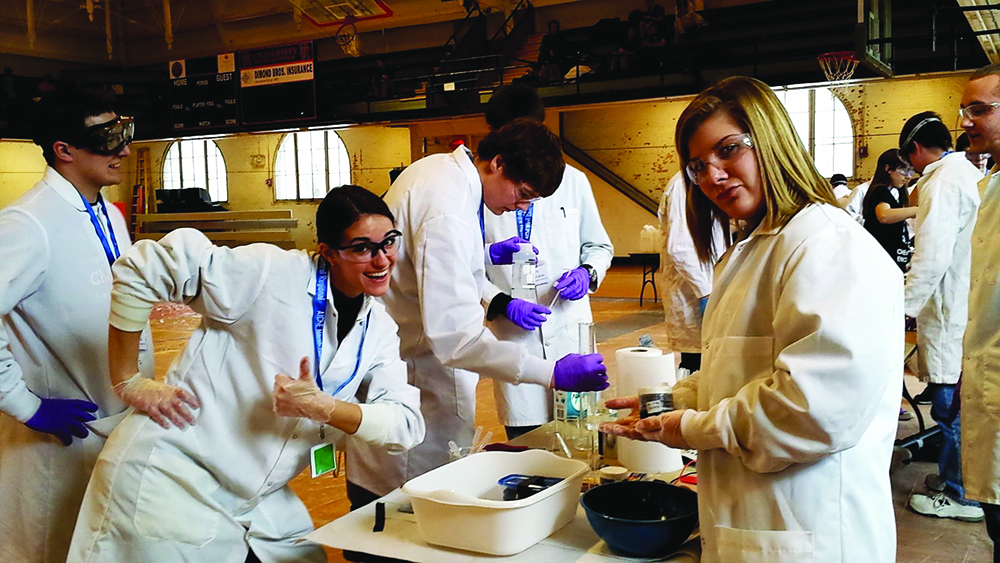By Liam Bouquet

After receiving second place at the American’s Institute for Chemical Engineers’ regional Chem-E-Car competition in Illinois, the Youngstown State University team of engineering students are preparing for their journey out to Salt Lake City, Utah for the national competition this November.
At the regional competition in early March, the YSU team of eight engineers competed against 14 other Midwestern universities, beating teams from University of Michigan, Ohio State University, University of Minnesota and University of Notre Dame.
The Chem-E-Car competition challenges the teams to create a car that is started and stopped by a chemical reaction. The team, then, is tasked with traveling a certain distance with a certain load of water placed on the vehicle within two minutes — the specifics of the distance and water load were not given to the teams until the day of competition.
The victors were determined by which teams ended closest to the distance line; YSU’s car ended 0.43 meters from the line.
Alex Lincoln, a senior chemical engineering major and the leader of YSU’s team, described YSU’s car.
“It is a little 3-D printed model of a pickup truck, and it runs on a zinc-carbon battery and uses iodine clock reaction to stop the power to the motor,” she said. “No other teams utilized 3-D printing in their vehicle design. Judges, students and general attendees to the conference loved the design and were very impressed. Teams usually have cars that look like robots with coils, valves and beakers showing. YSU wanted to be a little more creative and use the 3-D printer to our advantage and make it look like an actual car.”
Each team was given two hours to prep their car. YSU’s team split into two groups — one to manage the battery and one the iodine clock reaction. The battery determined the speed of the car, and the concentration of the iodine clock mixture determined the stopping point.
Holly Martin, a professor of civil, environmental and chemical engineering and the team’s adviser, explained the knowledge and precision required to be successful in the competition.
“Our iodine clock — we can’t have brakes, no mechanical devices allowed — we timed it so it would turn black, cutting off our laser and then our car would coast to a stop. You basically had a grasp of how long it would take the iodine clock to turn on based on concentration and then you knew how long it would take your car to get to the distance you were going,” Martin said. “There were some teams there that their car didn’t even get off the line. … [YSU’s car] stopped second closest to the line. It moved very quickly compared to other teams, and it was a very well put together vehicle.”
Lincoln contributed the success to the substantial time and effort of the students involved. The team started work in August and Lincoln estimated over 300 hours poured into the project.
“I think what set us apart is it was our first year competing so we didn’t know what to expect, but our students took it very very seriously in comparison to some other schools that have been well established. … We spent so much time in the lab, plenty of time on all the paperwork we had to do. We were pulling late nights to 9, 10, 11 o’clock at night every week day trying to get this car ready to go,” she said. “We prepared based on what we knew just from what we have read online and everything that is posted online is based on the national level. So basically we were prepared to compete at a national level and it ended up paying off really well.”
Jason White, a senior chemical engineering major and another leading member of the team, added that the team’s success proved the clout and excellence of YSU’s engineering program.
“I know I have heard from some juniors that ‘Wow, I never thought we could compete with them, maybe this program is not as underrated as it seems to be.’ Our quality of students are just as good as those other schools, and I think it is going to motivate underclassmen to maybe go into chemical engineering at YSU and maybe motivate them to join this team,” he said.
From here, the team will prepare the car for the national competition, which will follow the same rules as the regional competition.
“We are actually allowed to change any part of the car that we would like to, which is kind of a benefit because that gives us plenty of time to fix any errors or tweak anything just to make it a little bit more predictable. But I think a lot of time is going to be spent with the circuit board, altering that and making it a little bit more smooth and controlled. And, also, trials upon trials of work using the homemade batteries and the iodine clocks,” Lincoln said.
The team was able to raise approximately $3,000 for this competition, through sponsorship by Vollourec, Delphi and the YSU Student Government Association. The car was 3-D printed by the Center for Innovation in Additive Manufacturing.
Lincoln said the team must worry about raising funds for nationals — which will be three times the cost of the regional competition according to Martin. In addition, Lincoln said the team will have to find at least three new members for the team.
“It is actually going to be a little bit difficult because six out of the eight members on the team are graduating and the way that the competition works is that if you are not currently a student, then you are not allowed to compete on the team. Certainly we have two students who know the car very well who are left to compete, which means we have to do a lot of recruiting and training for a bunch of new students to complete the team,” she said. “There is a minimum of five members that have to go, so that is going to be a struggle trying to get a bunch of new people in there to understand the car as well as the current people do right now.”
Members of the YSU team that competed at Illinois include Lincoln, Nicole Abate, Diana Konik, Christopher Rudzinskas, White, Michael Maravola, Bridger Kowalczyk, Samuel Faykus and Josh Bilger. Michael Crescimanno, professor of physics and astronomy, and Tim Styranec, environmental specialist in the Office of Environmental and Occupational Health and Safety, also assisted the team.
